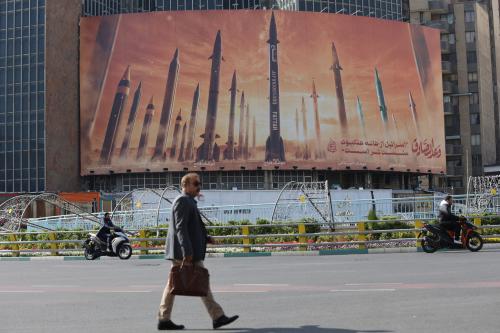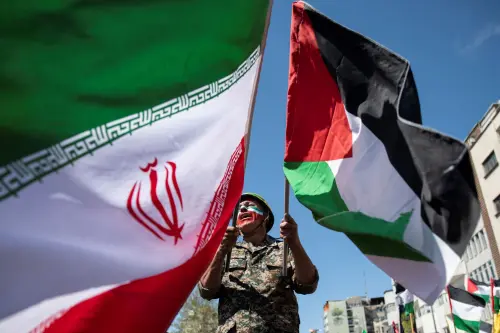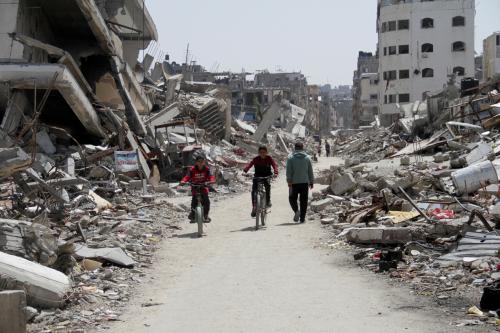In the approach to the five-year anniversary of the U.S. invasion of Iraq, senior officials from the two most important allies of the new Iraqi government visited Baghdad to mark the occasion. Iranian President Mahmoud Ahmadinejad was greeted by his Iraqi counterparts with all the elaborate pomp and circumstance associated a state visit, the first by an Iranian leader in 30 years and the first of any regional leader since the 2003 invasion. Two weeks later, U.S. Vice President Dick Cheney also made his way to Baghdad. However, despite his infamous pre-war prediction that U.S. forces would be greeted with “sweets and flowers,” security conditions forced him to travel under a blanket of secrecy, on a plane carrying a specially reinforced trailer for his sleeping accommodations in a country where 155,000 American troops patrol.
The contrast between Ahmadinejad’s triumphal reception and Cheney’s furtive and fortified stopover speaks volumes about the strategic legacy of the Bush Administration’s decision to use military force to remove the bloody dictatorship of Saddam Hussein. Of the many American illusions and delusions surrounding this war, the Administration’s calculations with respect to Iran were among the most wildly off base. Instead of generating a liberal, secular democracy whose reverberations would drive out Iran’s clerical oligarchs, the disastrous Bush policies fostered a sectarian Iraq that has helped empower Iranian hardliners. Rather than serving as an anchor for a new era of stability and American preeminence in the Persian Gulf, the new Iraq represents a strategic black hole, bleeding Washington of military resources and political influence while extending Iran’s primacy among its neighbors.
Like so much else that went wrong in Iraq, the post-war dynamic between Baghdad and Tehran should have been easy to foresee. Iran’s leaders cultivated enduring ties with all the significant Iraqi opposition groups over the course of their long adversarial relationship with Saddam Hussein. None of these groups could have been considered wholly-owned clients of the Islamic Republic, but their varying degrees of intimacy with and fealty toward Tehran almost universally surpassed their tactical cooperation with Washington in the run-up to the war and its aftermath. Moreover, as the only organized political forces in the post-war period, the Shia and Kurdish oppositionists were uniquely positioned to take advantage of the power vacuum, facilitated in no small part by retention of their militias.
American officials relied upon the expectation that the two countries’ nationalist identities would outweigh any sectarian cohesion, a conclusion supported by the experience of the eight-year Iran-Iraq war. But the U.S. failed to anticipate that in post-war Iraq, sectarian and nationalist interests have been largely conflated for the newly-dominant Shia and Kurds, propelling their leaders to utilize the benefits of an alliance with Tehran to entrench their own positions. Moreover, the Bush Administration appears to overestimated the significance of ideology in framing Iran’s approach to the new Iraq, hoping that a heavy-handed effort to export the Islamic revolution would alienate Iraqis. Instead, Tehran has behaved far more prudently, opting to support a democratic framework that privileges Iran’s allies in Iraq. At the same time, Tehran has sought to increase the cost of a continued American presence in Iraq through support to insurgents, in order to maximize its own position within the country and leverage vis-à-vis Washington.
Iran’s strategic and financial investments in Iraq reflect the regime’s deeply-held conviction that Tehran has an existential interest in ensuring a friendly government in Baghdad, one that is no longer capable of threatening Iran directly or on behalf of the international community. For Iran’s post-revolutionary leaders and society, the 1980-88 war represents the single most influential formative experience, inculcating a persistent sense of strategic vulnerability and a willingness to do whatever necessary to ensure the survival of both the Iranian nation and the Islamic state. This worldview underlies Tehran’s assiduous and wide-ranging extension of influence in post-war Iraq.
As developments repeatedly refuted its initial assumptions about the dynamics between Iraq and Iran, the Bush Administration at first sought refuge in denial, absurdly predicting that each new carefully-orchestrated leadership transition in Iraq would generate more distance between Tehran and Baghdad. More recently, the Administration has moved more forcefully, seeking aggressively to obstruct Iranian support to militias and insurgents. These actions are necessary to ensuring greater security for American forces in Iraq, but ultimately the real means of protecting Iraq’s sovereignty from intrusive neighbors does not involve expanding U.S. presence and responsibility within the country. In the long term, Iraqi leaders will only begin to differentiate themselves from Tehran when they are forced to grapple independently with the painful alternatives of governing and assume greater responsibility for their country’s security.
In addition, the broader American strategy appears fated to repeat the sort of ill-informed misapprehensions that informed the Bush Administration’s initial steps in Iraq. In response to growing regional trepidations about Iran’s activities in Iraq, Lebanon and Palestine, Washington has endeavored to transform a strategic deficit into an advantage. The concept was catalyzed by the July 2006 war in Lebanon, which Secretary of State Condoleezza Rice characterized at the time as “the birth pangs of a new Middle East.” Rice was widely lambasted for her tin ear, but the rhetoric signaled the Administration’s decision to embark on building a new platform for America’s role in the region. Initiatives such as the Gulf Security Dialogue and GCC-plus-two discussions (Egypt and Jordan) were intended to capitalize on Sunni Arab concerns about the rising tide of Iranian influence to leverage a more assertive posture vis-à-vis Tehran in exchange for their support for a revived Arab-Israeli peace process.
However, beyond routine exchange of pleasantries and a new stream of arms sales running into the tens of billions of dollars, it is unclear what these initiatives have actually accomplished. Shortly after its rejuvenation at Annapolis, the peace process quickly descended once again into violence, stalemated by the incapacity of both sides to undertake meaningful unilateral concessions. And despite their significant misgivings about Iran, the Arab states of the Persian Gulf have made clear – through a series of visits and high-level dialogue – that they will not form the bulwark of an anti-Iranian coalition, even as they privately urge Washington to resolve the Iran problem. For their part, Iran’s leaders have demonstrated some awareness of the need to maintain a constructive relationship with Riyadh and the Gulf states, dispatching envoys to Riyadh repeatedly over the past several years to assuage concerns over Ahmadinejad’s rhetoric and Iran’s escalating tensions with the West.
As with all aspects of the Iraq dilemma, there are no magic bullets that will ameliorate the significant setbacks for U.S. interests inherent in the extension of Iran’s influence in Iraq. Five years into this endeavor, neither rhetoric nor alliance-building will enable Washington to reset the clock to 2003. We will have to utilize multiple instruments and approaches to contend with a newly ascendant Iran – containment, active deterrence, and even accommodation and engagement. Tehran has shrewdly exploited the opportunities presented by America’s stumbling in Iraq; the challenge for the next Administration will be to acknowledge the realities of regional dynamics and regain the strategic advantage.



Commentary
Op-edHow the Iraq War Has Empowered Iran
March 21, 2008